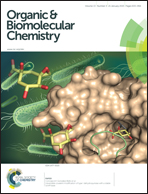New synthesis and biological evaluation of uniflorine A derivatives: towards specific insect trehalase inhibitors†
Abstract
7-Deoxy-uniflorine A (6), synthesized ex novo with a straightforward and simple strategy, and the analogues 4, 5 and 7, were evaluated as potential inhibitors of insect trehalase from Chironomus riparius and Spodoptera littoralis. All the compounds were tested against porcine trehalase as the mammalian counterpart and α-amylase from human saliva as a relevant glucolytic enzyme. The aim of this work is the identification of the simplest pyrrolizidine structure necessary to impart selective insect trehalase inhibition, in order to identify new specific inhibitors that can be easily synthesized compared to our previous reports with the potential to act as non-toxic insecticides and/or fungicides. All the derivatives 4–7 proved to be active (from low micromolar to high nanomolar range activity) towards insect trehalases, while no activity was observed against α-amylase. In particular, the natural compound uniflorine A and its 7-deoxy analogue were found to selectively inhibit insect trehalases, as they are inactive towards the mammalian enzyme. The effect of compound 6 was also analyzed in preliminary in vivo experiments. These new findings allow the identification of natural uniflorine A and its 7-deoxy analogue as the most promising inhibitors among a series of pyrrolizidine derivatives for future development in the agrochemical field, and the investigation also outlined the importance of the stereochemistry at C-6 of pyrrolizidine nucleus to confer such enzyme specificity.


 Please wait while we load your content...
Please wait while we load your content...